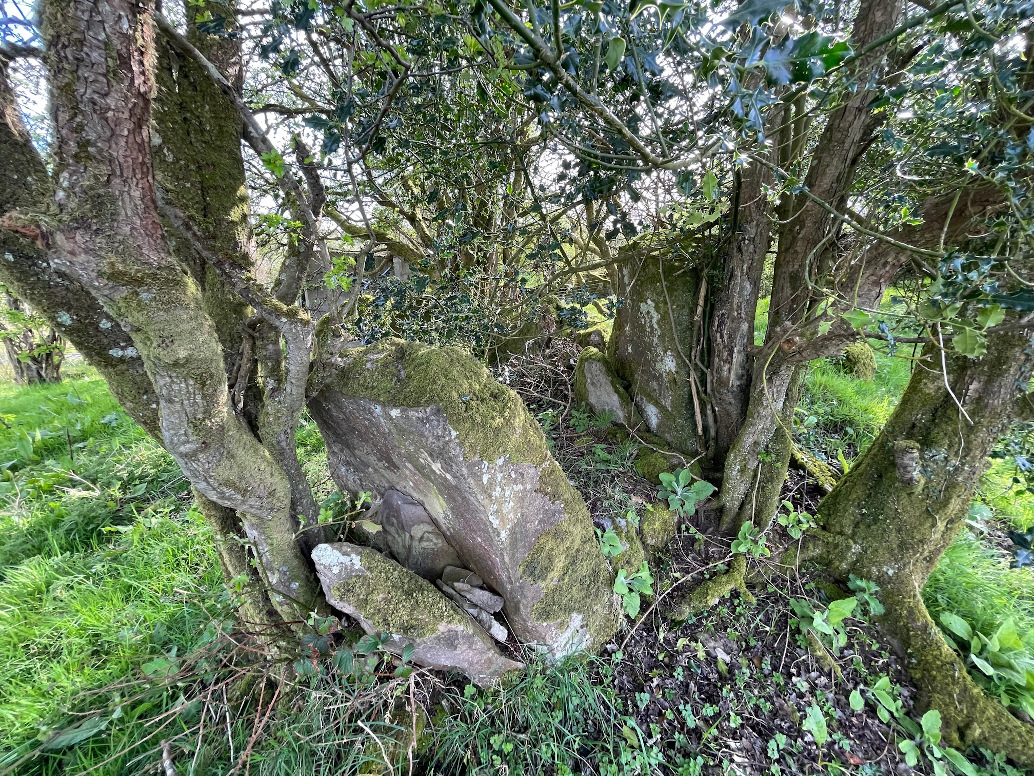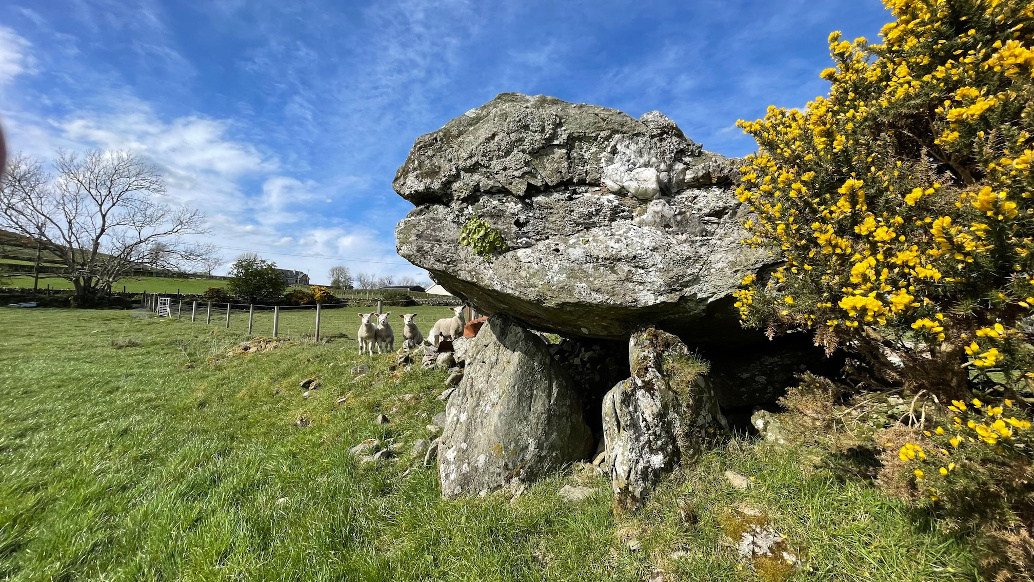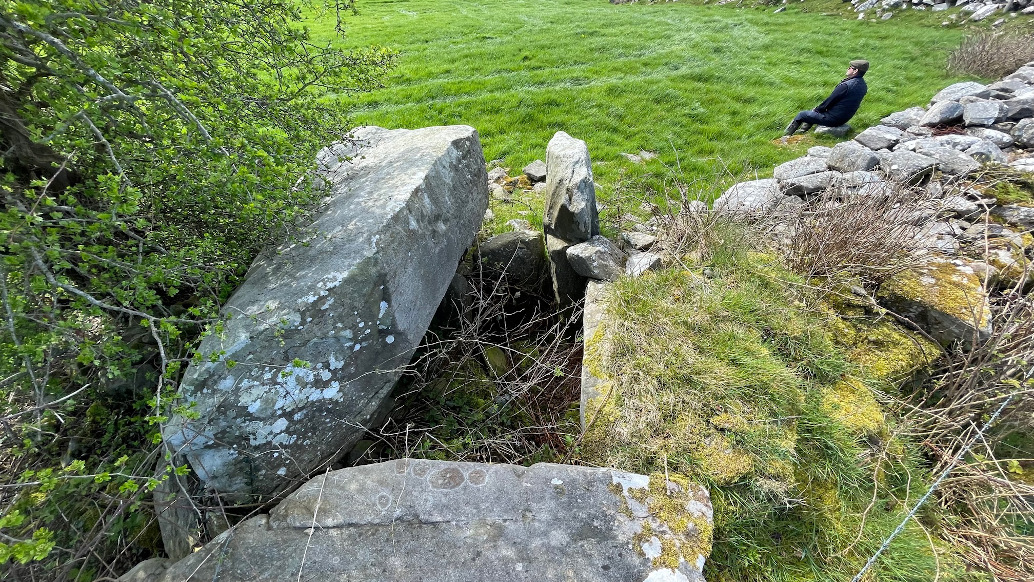



Lush summer grass in the forecourt at Knockoneill – the stones in the foreground are later, bronze age additions.

From the rear of the tomb, looking west towards Carntogher and the eastern Sperrins.

East over the entrance and chamber – the roofstones have been dragged off, allowing the chamber to fill with soil and rubble.


The west-facing entrance to the tomb. The stone in the foreground is a probable roofstone.






A rare Bronze Age spearhead has been found by workers while developing a wetland in Gloucestershire.
Experts discovered it at Cirencester Sewage Works, near South Cerney, earlier this year and on 10 May estimated it is about 3,500 years old.
Archaeologists said it appeared to be a family heirloom that was placed into a pit for a reason unknown.
Other items unearthed include a selection of prehistoric pottery fragments and flint tools.
A previously unknown stone circle has been found inside a Cornwall scheduled monument, a conservation group says.
The underground circle has been found inside Castilly Henge, near Bodmin, by Historic England (HE) and the Cornwall Archaeology Unit.
It was found during the site’s first modern archaeological survey to better understand the area, HE said.
The site has now been fenced, allowing it to be grazed by animals without damaging the structure, it added.
The henge is one of 40 scheduled monuments protected by the Cornwall Area of Outstanding Natural Beauty.
This place begs a couple of questions, the first of which is well rehearsed: Is it always important to remember that what we see at sites like Ballyrenan are the denuded, skeletal, interior remains of an earthen and stony mound? And does what remains at Ballyrenan cast doubt on that critical assumption in the first question? Because, like at Ballyvennaght in Antrim, there are two tombs here, separate but part of the same monument. At Ballyvennaght the entrance to the still standing western tomb is to the west, outwards from the cairn/mound – the collapsed eastern tomb is said to have a possible backstone at the west of the capstone so it must have opened to the east, again outwards from the cairn/mound.
At Ballyrenan, both chamber openings face east, meaning the western chamber would face into the mound/cairn. There is the possibility that there was come sort of central court in the intervening space between the front of the western tomb and the rear of the eastern. So was this a mongrel combination of a court and portal tomb? The fact that the western tomb has two chambers could lead you down that rabbit hole. But all of these musings are for later – today the sun is shining and this fantastic monument is right beside the country lane.
The large farm buildings to the west of the tomb do detract from the vibe a bit. The farmer’s there working away and gruffly gives us the go-ahead to park in the driveway. And then it’s just dive right in. It’s not massively spectacular in terms of size but this place has something else, something mysterious and deeply affecting. The thought taken to form the construction and the skill to complete it are impressive. And yet doubts remain – was the western tomb messed about with and re-constructed sometime after the supposed denudation of the cairn/mound? Because there’s a couple or three things amiss, or unique, or odd about the western tomb, aside from it facing into the mound, if there ever was one.
One: the skewed ‘lintel’ over the portal stones, propping up the capstone but also tilting it down to the north as it rests neatly on the southern, but precariously on the northern portal. Two: the stone that rests on the north-eastern sidestone of the eastern, front chamber that juts out by at least a metre and serves to counter the tilt caused by the portal ‘lintel’. The capstone of the rear chamber also rests on this stone. Three: The rear, sealed chamber itself. But sure what am I cribbing about? The easy, quiet backwoods atmosphere allowed us to engage with and immerse in the monument for as long as we wished. I couldn’t resist attacking the ivy that is beginning to colonise the northern portal of the western tomb, the physical action bringing the engagement to another level.
The ‘lesser’ eastern tomb has its own charms too. The stone that I thought to be a recessed, half-height doorstone, but actually a septal stone, is split longitudinally by a seam of quartz, discovered after another judicious bit of ivy clearing. The backstone is there, as are the two sidestones and both portals – all that’s missing is the capstone. The excavators discovered a small, cist-like second chamber at the back of the main chamber but we didn’t notice. If that was the case and it’s also double-chambered, then I would be leaning towards two separate monuments and two separate mounds. Either way it would have been an impressive, close to medium-sized dolmen when complete.
Ballyrenan is another must-see Tyrone site. I’d been in the vicinity a couple of times in the last few years and had neglected it for some reason, probably because of the multitude of other fantastic places in the county. Don’t make the same mistake!

A little under half the circumference of the ‘circle’.
There’s just no getting away from how colossally weird these stones are – you feel that anything that you say about them would not in any way do them justice. It’s a bit like being confronted by Munch’s Scream, a raw shout from the core of us, pointing to our own ultimate annihilation and rendering us silent. They are both ghostly and otherworldly, and weirdly human at the same time, leaving you with your consolatory pondering. I don’t have much else to say, just that you have to see them.
The Lusty More man is obviously the lesser of the two here but, on its own, would have you travelling miles to see it. Faded now, it’s power waning, and placed so close to the ‘Janus’ figure, you get quickly distracted. However, all is not well at Caldragh – to my untrained eye, the Janus figure is beginning to erode badly, almost crumbling in places. I would understand entirely if it was moved indoors. That said, it would be a shame if it happened – the experience of having this place all to yourself, to contemplate the utter strangeness of the carvings, is one of the highlights of megalithic Ireland.
Like the shattered, semi-devoured carcass of a beached whale, the remains of Cavantillcormick dual court tomb sit on a slight, boggy ridge, scattered stones jutting above the turf and what’s left of the cairn in a barely discernible pattern. I’d approached the monument from the neighbouring field entrance about 250 metres to the south-east, gone down into a ditch and clambered up over a wall and then traversed the marshy ground to be confronted by what is a wreck of a tomb that manages to retain just a small bit of dignity.
Thankfully what does remain doesn’t seem in any danger of being removed, for the moment. Much of the poorer land in Fermanagh, and Tyrone for that matter, seems to be in the constant process of improvement. You would hope that any ideas of that here would take the neolithic court tomb into account, but there’s no guarantee of that. Cavantillycormick (probably Cabhán Tulaigh Cormaic ‘hollow of Cormac’s hill’) and its surrounds has a mix of pasturage and a small amount of tillage and land hunger may return.
You could despair at the destruction here but of the remains of the two tombs, the western is better, with a displaced roofstone over its chamber. The sense of tragedy is increased at the eastern remains, two, maybe three stones left standing. Still, there’s a sense here of something that is yet worthwhile. The ruggedness, the barely contained wildness, the raw beauty of the surroundings, and the wreckage of the ancient memorial, all combine into a small celebration of the determination of those who eked out their existence here all the way back six thousand years ago.

Shot taken from the southern, rear of the cairn to give an idea of the extent of the long cairn.

The entrance is blocked by cairn rubble, added by some enthusiastic but misguided visitors.





North over the subsidiary chamber towards the lintelled entrance of the main chamber.



Collapsed roofstone now rests on the southern sidestone.
The scant remains here lie one and a half kilometres west of the centre of Omagh town. The deep spring green of the fertilised fields is almost off-putting. Ballyrenan is only 12 kilometres northwards so why bother? Nothing much is visible from the road and at first the layout of the SMR map has me confused, almost enough to give up. Then, oriented correctly, I leg it south, uphill and close to the field boundary.
The very box-like/cist-like remains, incorporated into the field bank, get inundated in the summer – now, in mid-April, it’s still difficult to see the southern part of the tomb, vicious, dry brambles from last year still tangling two of the orthostats. They say it’s the possible remains of a court tomb – various scattered stones could be this or that. I didn’t hang about much, Ballyrenan too much of a distraction.


Two fairly well-matched portal stones, though you’d never tell with all the trees.



Looking west. The eastern sidestone and the capstone are missing.
The A505 runs between Omagh and Cookstown and is a fast and unforgiving road. It’s also littered with megaliths to its north and south. Heading west from An Creagán, we pulled up on the northern verge at the bottom of the field. I didn’t wonder who might have been interred in the tomb we were visiting. It was just another ruin, taken in on our way to better places, but revered nonetheless.
It’s tucked in under, and almost incorporated into, an ancient but later field boundary. It’s aligned east/west, with the front at the west. The map says megalith, the SMR court tomb. Any remains of the shallow court are difficult to discern – some of the stones here seem to be dumped field clearance, though the field is little more than a bog now, poorly drained. Mulderg rises to the north-west, scarred terribly with the gouges of quarrying. South-east is a long expanse of heather covered bog.
Most of the gallery sidestones remain, presuming there was only one chamber. A laterally placed stone on the southern side may be a segmenting jamb. There is no stone opposite it at the north so there’s no telling. Two matched stones further east and no closing stone at the rear leads to the conclusion that the rear of a second chamber may have been robbed. Two stones, one splayed out over the entrance stones and another thrown down in the ‘court’ may be roof stones or lintels.
I doubt this place ever fully dries out. It’s not a showy sort of place and is almost stranded there 200 metres from the road as the traffic flies past. I had no huge expectations and I can’t say I was either under- nor overwhelmed. It’s a small relic in an area with many more ‘important’ sites but might be worth your efforts, just bring some wellies.



Was the whole facade of the capstone once covered in quartz?

Flat-faced capstone – you can see the large chunk of quartz.


The front of the monument – there’s quite a substantial wedge tomb in there somewhere.

One of the chamber roofstones – the chamber has been filled in with soil.



Overgrown and pretty much filled in, there’s quite a well-preserved wedge tomb below all the mess.

Along the line of the chamber, the tomb is not quite aligned on Muckle Hill to the west in the distance.




The tomb is aligned just south of west – the front capstone has slid to the south, I’m standing on the rear capstone.